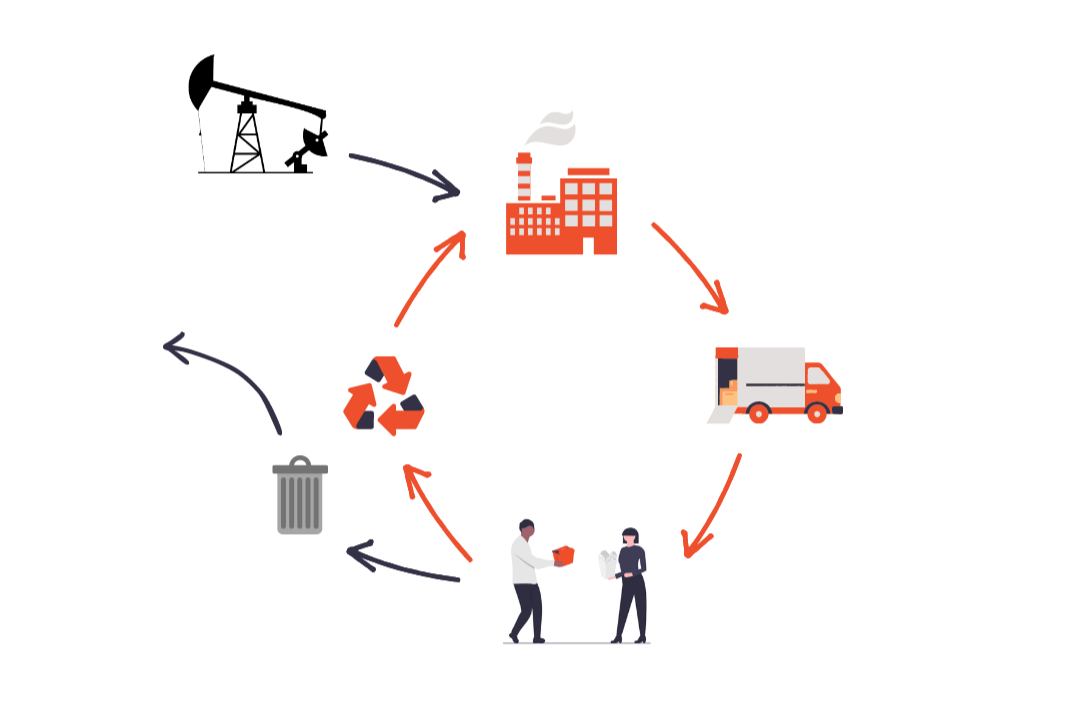There is a wide range of tools available for measuring environmental impact. Carbon footprinting and life cycle assessment (LCA) are among them. Knowing the difference between an LCA and a carbon footprint is essential if you are to make an informed choice in line with your corporate objectives. Here’s a guide to help you do just that.
What is an LCA or Life Cycle Assessment??

According to the International Reference Centre for Life Cycle Assessment and Sustainable Transition (CIRAIG), life cycle assessment is “an approach and a decision-making tool for assessing the potential environmental impacts […] of a product or service. It is a comprehensive approach that encompasses all the stages in the life of a product or service, as well as a wide range of sustainability issues“.
And what is the carbon footprint?
The carbon footprint is the measurement of an entity’s impact on the climate. This entity can be :
- a person;
- a country;
- a building;
- an event;
- a sector of activity;
- an organization (company, NPO, etc.);
- and much more!
How are LCA and carbon footprint different?
On the one hand, in an LCA, a product’s or service’s carbon footprint is established, in addition to measuring its impacts on many other environmental spheres, such as waterways, human health, biodiversity, the exploitation of primary resources, and so on. These impacts are then quantified at every stage of the product or service life cycle. These range from extraction of the necessary primary resources, through assembly, packaging, distribution and use, to end-of-life (landfill). This approach avoids shifting an environmental problem from one sphere to another. However, the exhaustive nature of an LCA implies the processing of a very large volume of data. For this reason, LCA requires specialized software, time, resources and often research.
On the other hand, since the carbon footprint can be applied to many entities other than a product or service, it is not constrained to life-cycle stages. It is therefore more flexible and generally quicker to perform. For example, at Will Solutions, you can measure the carbon footprint of your buildings to find out the climatic impact of your business activities.
Simplified LCA example: the cotton T-shirt


In the LCA of a cotton T-shirt, we’ll consider the amount of water, fertilizers and pesticides needed to grow the cotton. It will also include the electricity needed to manufacture and store the T-shirt, as well as the amount of soap needed to wash it after each use. The LCA will also include the amount of diesel needed to plough the fields and transport the product throughout its life. The LCA will also include the impact of landfilling.
In contrast, the carbon footprint will include only those activities that emit GHGs, i.e. fertilizer application, diesel and landfill. However, since the carbon footprint is not constrained to the life cycle, we could also choose to measure the climate impact of a company that grows cotton, or measure the climate impact of the manufacture of cotton T-shirts in Quebec. The possibilities are endless!
Why do a Life Cycle Assessment or Carbon Footprint?
Despite their differences, the two tools share certain applications. For example, both tools can be used to :
- Compare products or services
- Identify activities or life cycle stages with the greatest impact and assess potential for improvement
- Ecodesign
- Obtain environmental certifications
1) Compare products or services
On the one hand, LCA will give a picture of the impacts of the products or services being compared on each of the environmental spheres. To take the clothing example, a cotton T-shirt may have less impact on human health than another type of T-shirt, but it may have a greater impact on the climate. For its part, the carbon footprint will highlight the best product for the climate.
2) Identify high-impact activities and assess potential for improvement
The LCA will show the major impacts of activities by environmental sphere. For example, pesticide spraying in cotton fields could have the greatest impact on aquatic biodiversity, while delivery could have the greatest impact on climate. The carbon footprint will highlight which activity emits the most GHGs. Knowing the impacts, we can assess the potential for improvement.
In fact, at Will Solutions, the carbon footprint is accompanied by a personalized report with project opportunity plans to reduce your GHG emissions. Then, GHG reductions can be monetized in carbon credits. In this way, you are financially rewarded for your efforts on behalf of the climate.
3) Ecodesign
Where potential for improvement exists, LCA or carbon footprint results can be used to guide the design of a new product or service with reduced environmental or climate impact.
4) Obtain environmental certifications
If your goal is to obtain environmental certification, there are several certifications associated with both tools. Here are just two: you can obtain EcoLogo certification for a product or service that has a reduced impact on the environment or human health. But you can also obtain Climate Neutral certification after reducing and offsetting your GHG emissions following a carbon footprint.
In short, the tool you choose depends on your objectives and resources. The following table summarizes the main points:
| Life cycle assessment (LCA) | Carbon footprint |
| Measuring impacts in various environmental spheres. | Calculation focused on contribution to climate change (GHG) |
| Product or service analysis | Analysis of a product, a service, a person, a building, a country, a company, a sector of activity, etc. |
| Report on the life cycle of a product or service, from extraction of raw materials to landfill. | Not limited to the life cycle. |
| Exhaustive analysis; often requires time, resources and research | Flexible and generally faster analysis |
| They have essentially the same applications | |
If you have any questions, please contact us! We’ll be happy to guide and support you in achieving your environmental objectives.


Anne Ménard
GHG auditor
Author of the article

